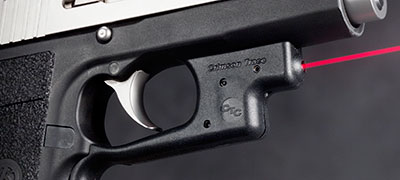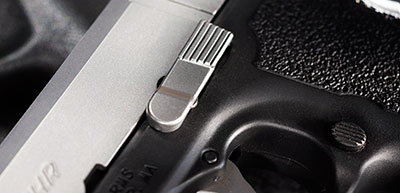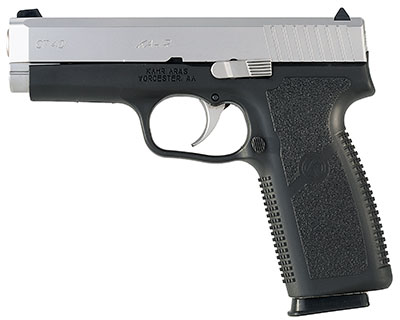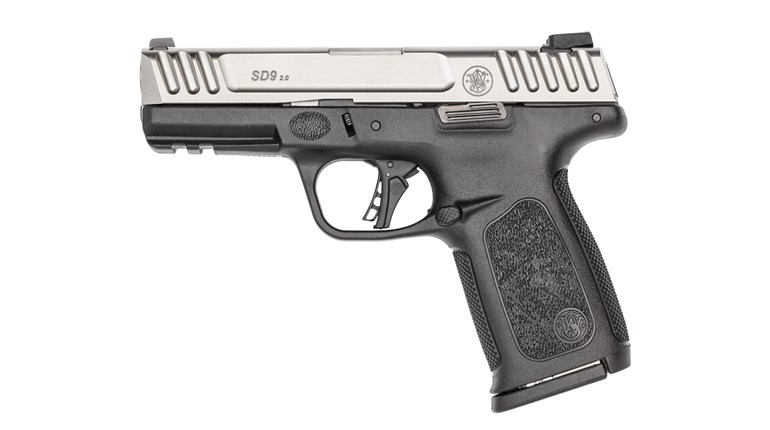
Despite being a lifelong devotee of the Model 1911, I’ve always liked and admired the Kahr family of pistols. They’ve all been well made, functioned smoothly and focused on resolving specific threats their owners are likely to face. Each generation of Kahr pistol has filled a niche requirement for those citizens who choose to protect themselves under the provisions of the Second Amendment. It’s no wonder Kahr owners are so loyal to the brand.

This year, Kahr introduced the CT series of pistols variously chambered in 9 mm, .40 S&W and .45 ACP. These are full-frame, value-priced pistols with increased dimensions that put them in (or near) the size range of a true service pistol. The .40 S&W-caliber CT I received weighed just less than 22 ounces, which is only 4 or 5 ounces heavier than the smaller-frame Kahrs. The CT series of Kahr pistols can be open carried like a duty pistol, or easily concealed under clothing.
Let’s clear the air on possible biases. I’m not a fan of the .40 S&W. Given today’s high-performance pistol ammo, I’m not convinced the .40 S&W cartridge will do anything that can’t be done by the smaller 9 mm or larger, slower .45 ACP. What the .40 does, however, is generate higher operating pressures and a sharper recoil impulse. Putting those things into a pistol designed and sized for the 9 mm has an associated trade-off. That said, a .40-caliber pistol generally gives you an extra round or two of ammo in the magazine, compared with a .45 ACP and makes bigger holes than a 9 mm, even on those occasions where the bullet fails to expand properly. I know law enforcement agencies have mass-migrated to the .40 S&W, but that was partly because of all the hoopla around its introduction following the calamitous 1986 FBI Miami shootout.

Like other Kahrs, the CT40 is a locked-breech, striker-fired pistol. Pulling the trigger does all of the work in that it cocks and fires the gun; there is no energy “stored” in the striker by cycling the slide. A passive striker block prevents the pistol from firing should it be accidentally dropped. The Kahr does not have a magazine disconnect, so it can be fired with the magazine removed. I consider this absence a mandatory requirement in a defensive pistol.

The CT40’s rear sight is dovetail-mounted into the matte stainless steel slide and is drift-adjustable. The front sight is pinned and has a white dot in the rear face of the blade. The rear sight has a white line (really more of a white square) at the base of the notch that lines up nicely with the front dot. It’s an excellent sight arrangement for bright daylight to low-light conditions in that the “black on black” provides a clear, conventional sight picture in daylight while the white dot/square line up nicely against a darker background or in a low-light confrontation. The CT’s sights don’t glow in the dark like true night sights, but I prefer the less-complicated dot/line setup to the more prevalent three-dot system found on many defensive pistols.
There are some serrations at the rear of the slide but none near the muzzle. The serrations are aggressive enough anyone with reasonably normal hand strength should have no trouble manually operating the slide. The front end of the slide is beveled on both sides, which will facilitate holstering—a valuable asset for a concealed-carry pistol, particularly one that might be carried in an IWB holster. The pistol’s external extractor is mounted in the right side of the slide, and it appears to be the same type used on the smaller Kahrs. It worked 100-percent reliably during range sessions with my production-model sample. The polished feed ramp appears to be the same as on the more expensive PM series of pistols.
The black polymer grip frame is textured with a rather gently pebbled surface on the sides of the grip and a more aggressive molded checkering-like surface on the frontstrap and backstrap. Between the textured finish and the extra length of the frame that promotes a solid grip with all fingers of the shooting hand, the .40 S&W-caliber is reasonably manageable in prolonged strings of fire. You’ll have to judge for yourself how “reasonable” it is, because this is a lightweight .40 S&W-caliber pistol, not a 9 mm.
One of the cost savings employed by Kahr on the CT series is in the barrel. The value-priced handguns utilize conventional rifling, not polygonal rifling. My first recollection of polygonal rifling was from Marlin in its .22 rifles a few decades back. And again, relying on my increasingly unreliable memory, the literature of the day implied the new rifling improved accuracy when using jacketed bullets, but experienced degraded accuracy from lead bullets. On my “budget” back then, I shot whatever I could get my hands on, and never really worried about the high-tech discussions. I still can’t get excited about the difference in accuracy caused by a rifling change in a lightweight, defensive pistol with fixed sights. The CT40’s conventional rifling produced the groups shown below using only jacketed ammunition, and while the pistol had “preferred” loads, none of the results would have failed to end a fight.

Neither could I get too worked up over most of the other cost-saving techniques Kahr utilized in making the pistol. Engraving technique on the side of the slide is meaningless in a defensive pistol. Roll marks instead of engraving is in the category of “Who cares?” A reduction in the number of machining operations on the slide might make a tiny difference in weight, but again, nothing worth discussing. The result is a smooth exterior minus sharp edges, in essence a nicely “dehorned” pistol. A pinned rather than dovetail-mounted front sight means it’s more vulnerable to damage, but you haven’t lost the ability to make necessary drift adjustments since the rear sight is dovetailed. The trigger is the same in the CT as in the more-expensive models, which means while it’s not as short and crisp as a 1911, it is an excellent striker-fired trigger. The pull weight is consistent and smooth throughout its travel; it just has to travel farther than a 1911. A discussion of a machined slide-stop lever as opposed to a metal-injection-molded (MIM) lever is much like the pinned versus dovetail front sight discussion. MIM parts are not as tough as machined components, but as long as the part doesn’t break, it doesn’t matter. And while I’ve heard of MIM pistol parts breaking, I haven’t seen it. All of these seem like a worthwhile effort by Kahr to get the MSRP down to $449. Not so regarding the idea of furnishing one magazine with the gun.
A big advantage of a semi-auto defensive pistol is it’s faster to reload than a revolver, but this is only true if you enter the fray with pre-loaded magazines. To reload a revolver, you put the individual rounds directly into the cylinder chambers. To reload a semi-auto, you must first put the rounds into the magazine and then insert the magazine into the gun, clearly an undesirable extra step when time is of the essence. If you haven’t ended the fight by the time your gun runs dry, do you really want to reholster, or worse, set the gun down somewhere while you reload your magazine? Yes, I’ve heard of folks who carry a pocket pistol with no reloads relying on just the rounds in the gun and their incredible fighting skills to resolve threats quickly and decisively. But I’ve never heard anyone knowledgeable recommend venturing forth without spare ammo. Even when carrying two handguns, it’s recommended you also have a reload for the backup gun.
 And then there is the rule of “Two is one, one is none,” which I first heard in a low-light defensive-shooting class. The presumption is things will likely break at the worst possible time, and if you only have one of something, suddenly you have none. If your one and only magazine malfunctions, at best you are left with a very inefficient single-shot pistol. Unfortunately, the CT40 Kahr sent me had a faulty magazine. Kahr isn’t the first manufacturer to have a magazine problem; I’ve encountered it before with several other major manufacturers. In fact, when any semi-auto pistol has a problem, the magazine is almost always the first part examined, and it usually proves to be the faulty component. The problem is only one magazine is furnished with each value series pistol, and I had no spares on hand for the CT40. This mag frequently failed to seat securely despite a vigorous slap on the base pad, and the sharp recoil impulse of the .40 S&W cartridge caused the magazine to drop part way from the mag well and the slide to close on an empty chamber. “Tap/rack” drills continued through the entire shooting session. When the magazine did remain seated throughout all seven rounds, it was extremely difficult to remove the magazine from the gun. I’ve not seen this problem on other Kahr pistols, nor have I heard of it occurring on any of the new CT value series, so I suspect this was a “one of a kind.” Getting only one magazine for a pistol is not an economical move, but rather a recipe for potential disaster. Even if your one magazine works perfectly, every time a spent magazine hits the ground there is the potential for damage. Besides, if a fight breaks out, you’ll wish you had at least one spare, which means you’ll need at least three magazines to ensure you have two.
And then there is the rule of “Two is one, one is none,” which I first heard in a low-light defensive-shooting class. The presumption is things will likely break at the worst possible time, and if you only have one of something, suddenly you have none. If your one and only magazine malfunctions, at best you are left with a very inefficient single-shot pistol. Unfortunately, the CT40 Kahr sent me had a faulty magazine. Kahr isn’t the first manufacturer to have a magazine problem; I’ve encountered it before with several other major manufacturers. In fact, when any semi-auto pistol has a problem, the magazine is almost always the first part examined, and it usually proves to be the faulty component. The problem is only one magazine is furnished with each value series pistol, and I had no spares on hand for the CT40. This mag frequently failed to seat securely despite a vigorous slap on the base pad, and the sharp recoil impulse of the .40 S&W cartridge caused the magazine to drop part way from the mag well and the slide to close on an empty chamber. “Tap/rack” drills continued through the entire shooting session. When the magazine did remain seated throughout all seven rounds, it was extremely difficult to remove the magazine from the gun. I’ve not seen this problem on other Kahr pistols, nor have I heard of it occurring on any of the new CT value series, so I suspect this was a “one of a kind.” Getting only one magazine for a pistol is not an economical move, but rather a recipe for potential disaster. Even if your one magazine works perfectly, every time a spent magazine hits the ground there is the potential for damage. Besides, if a fight breaks out, you’ll wish you had at least one spare, which means you’ll need at least three magazines to ensure you have two.
Kahr’s value series has a good trigger and excellent sight picture, two of the most-important features to ensure you do your best shooting. With the CT’s growth to an “adult-size” handgun, ergonomics are now also excellent, providing an improved shooting grip and more natural pointing characteristics. Other key features for a defensive pistol remain the same as on the deluxe series of guns meaning you’ve gained capabilities while reducing costs. The increased size makes the CT40 “iffy” as a pocket pistol, but not really difficult to carry concealed. But please, make the investment in a couple extra magazines when you order/buy it rather than waiting until after you’ve lost your first gunfight.







































